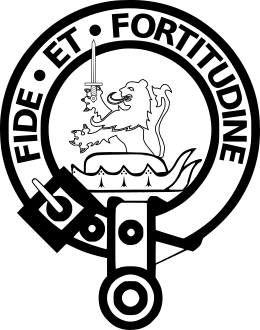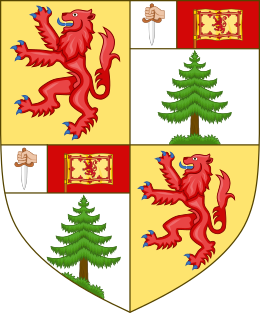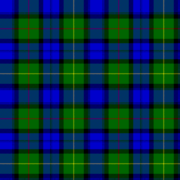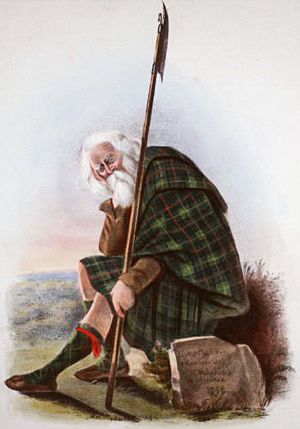Clan Farquharson facts for kids
Quick facts for kids Clan Farquharson |
|||
|---|---|---|---|
| Clann Fhearchair | |||

Crest: On a chapeau Gules furred Ermine, a demi-lion Gules holding in his dexter paw a sword Proper
|
|||
| Motto | Fide et Fortitudine ("By Faith and Fortitude") | ||
| Profile | |||
| Plant badge | Scots fir | ||
| Chief | |||
 |
|||
| Philip Farquharson of Invercauld | |||
| Chief of the Name and Arms of Farquharson (Mac Mhic Fhionnlaigh) | |||
| Seat | Invercauld Castle (historically) | ||
|
|||
|
|||
|
|||
Clan Farquharson (pronounced FARK-ər-sən) is a famous Highland Scottish clan. Their home is around Invercauld and Braemar in Aberdeenshire. The Farquharsons are also part of a larger group of clans called the Chattan Confederation.
Contents
History of the Clan
Where Did the Clan Farquharson Come From?
The Farquharson clan leaders can trace their family tree back to Farquhar. He was the fourth son of Alexander "Ciar" of Rothiemurchus. Alexander Shaw was the fifth chief of the Clan Shaw. Farquhar's descendants later took the name Farquharson.
Another of Alexander's sons, Donald, married Isobel Stewart. She was the heiress of Invercauld. Donald's son was Finla Mor, who is seen as the true founder of the clan. MacFionlaigh Mòr is a Scottish Gaelic name meaning "son of Finla the Great". Finla Mor was the royal banner bearer, carrying the king's flag, at the Battle of Pinkie Cleugh in 1547. He was killed in this battle.
However, Finla Mor had nine sons from two marriages. These sons started important branches of the clan, and the clan grew much stronger. In 1595, Clan Farquharson joined the Chattan Confederation. They made an agreement to recognize the chief of Clan Mackintosh (who was also the chief of Clan Chattan) as their main leader.
By the late 1500s, the Clan Erskine chiefs tried to claim the Earldom of Mar. But the Farquharsons were becoming very powerful and opposed them. In 1628, Braemar Castle was built by John Erskine to protect against the Farquharsons. But in 1716, the castle was taken by the Clan Farquharson. The clan became known as the fighting Farquharsons because they were fierce warriors. They were also strong supporters of the Stuart kings.
The 17th Century: Conflicts and Civil War
During the Scottish Civil War, Donald Farquharson of Monaltrie fought for James Graham, 1st Marquess of Montrose in 1644. He then fought for King Charles II at the Battle of Worcester in 1651.
John Farquharson of Inverey was known as the Black Colonel. He famously burned Braemar Castle. John supported King James VII of Scotland and followed John Graham, 1st Viscount Dundee in 1689. After Dundee's death, Clan Farquharson supported his successor, Thomas Buchan of the Clan Buchan.
In the late 1600s, the Earl of Airlie had a dispute with the Clan MacThomas over land. The Earl won in court, but the MacThomas chief still used the land for his cattle. So, the Earl leased the land to men of Clan Farquharson. This led to a conflict. In 1673, Farquharson of Broughdearg was killed, along with two sons of the Clan MacThomas chief. The legal battles that followed caused big problems for the MacThomas chief.
On the south side of the Black Isle, there are places called McFarquhar's Cave and McFarquhar's Bed. They are named after a smuggler from the 1600s.
The 18th Century: Jacobite Risings
During the Jacobite rising of 1715, another John Farquharson of Invercauld was a colonel in the Chattan Confederation regiment. This group supported James Francis Edward Stuart, who wanted to be king. Farquharson was captured at the Battle of Preston (1715). He was held in Marshalsea Prison and was sentenced to death at the Tower of London. However, he and two other Highland officers were saved on the morning they were supposed to be executed. He was later released but could not return to Scotland for over twenty years.
In 1724, a report by General Wade estimated that the Farquharsons and Mackintoshes together had about 800 fighting men.
In 1745, Duncan Forbes, Lord Culloden estimated the Clan Farquharson had 500 men. On December 23, 1745, 300 men of Clan Farquharson fought as Jacobites in their victory at the Battle of Inverurie (1745).
During the Jacobite rising of 1745, John Farquharson's cousin was Lady Anne Farquharson-MacKintosh. She was married to Angus Mackintosh, chief of Clan Mackintosh. Angus Mackintosh was actually an officer in the British Army's Black Watch regiment. He was captured by Jacobite forces at the Battle of Prestonpans. Mackintosh was sent home to Moy after promising not to fight against the Jacobites. When he arrived, his wife, Anne Farquharson, greeted him by saying, "Your servant, captain." He replied, "Your servant, colonel." After that, she was always known as Colonel Anne. Anne later helped Charles Edward Stuart escape capture in an event called the Rout of Moy. Anne was put in prison for six weeks after the Battle of Culloden. Francis Farquharson of Monaltrie led the Farquharsons at the Battle of Culloden. He survived but was imprisoned and sentenced to death. Luckily, his punishment was changed to exile.
The McFarquhars of Redcastle were also Jacobite supporters.
The Clan Today
Alwyne Arthur Compton Farquharson, who was the 16th Baron of Invercauld and Omnalprie, passed away on October 6, 2021. He was the Chief of the Name and Arms of Farquharson. Born in 1919, he was confirmed as the clan chief in 1949 and took the name Farquharson. He served bravely as a Captain in the Royal Scots Greys during World War Two. Captain Farquharson lived in Norfolk with his second wife. His great-nephew, Philip, has now become the new chief.
Clan Castles
Many castles have been important to the Farquhars and Farquharsons:
- Invercauld House: This strong, castle-like mansion is two miles northeast of Braemar. It has a large tower, battlements, and turrets. An old tower house is built into it. It was first owned by the Clan Stewart but became Farquharson property when Donald Farquharson married the Invercauld heiress. Their son was Finla Mor, the Royal Standard Bearer who died at the Battle of Pinkie Cleugh in 1547. It was from here that the Earl of Mar, leader of the Jacobite rising of 1715, called on the Jacobites to fight. The Farquharsons of Invercauld still live there today.
- Inverey Castle: Four miles west of Braemar, this was the home of John Farquharson of Inverey, known as the Black Colonel. He was involved in the killing of John Gordon of Brackley in 1666, as told in an old song. John Farquharson of Inverey also defeated a force attacking Braemar Castle, which he then burned. Inverey Castle itself was destroyed in 1689 after the Battle of Killiecrankie.
- Kindrochit Castle: These are the ruins of an 11th-century castle built by King Malcolm Canmore. The remains can be found in Braemar, across from the local butcher shop.
- Braemar Castle: Just northeast of Braemar, this is a 17th-century L-shaped tower house with turrets. It has star-shaped defenses from the next century. The Earl of Mar built it in 1628. But because they did not support King James VII of Scotland in 1689, the castle was taken and burned by John Farquharson of Inverey, the Black Colonel. When the Jacobite rising of 1715 ended, the castle passed to the Farquharsons of Invercauld.
- Monaltrie House: This house was held by the Farquharsons who fought for James Graham, 1st Marquess of Montrose in the 1640s and then for King Charles II in 1651. Francis Farquharson of Monaltrie led the Farquharsons at the Battle of Culloden. He survived but was imprisoned and sentenced to death. Luckily, his punishment was changed to exile. Monaltrie House was burned after the Battle of Culloden.
- Gilmilnscroft: Four miles southeast of Mauchline in Ayrshire, this T-shaped house was owned by the Farquhars from the 14th to the 20th century. It might include an older tower house. The building was restored in 1968 and is still lived in.
- Mounie Castle: Three miles northwest of Oldmeldrum, Aberdeenshire, this is a changed 17th-century T-shaped house with a round stair tower. It passed from the Clan Seton to the Farquhars in 1634 and then to the Clan Hay in 1701.
- Tolquhon Castle: Four miles east of Oldmeldrum, this is a courtyard castle with many buildings and a gatehouse with round towers. The original castle was built by the Prestons of Craigmillar but passed to the Clan Forbes in 1420, who built the current castle. It was sold to the Farquhars in 1716.
Clan Tartans
| Tartan image | Notes |
|---|---|
 |
Clanhiunla, or Farquharsonnes tartan, published in 1842. |
 |
Farquharson Modern tartan. |
| Farquharson Dress tartan. |
Clan Symbols
- Crest: A red half-lion holding a sword, on a red and white fur hat.
- Motto: Fide et Fortitudine which means "By Faith and Fortitude" (meaning strength and courage). Another motto is I force nae freen, I fear nae foe, meaning "I force no friend, I fear no enemy".
There are several different tartan patterns linked to the Farquharson name.
Images for kids
See also





